Functions 2
| © 2009 Rasmus ehf og Jσhann Νsak |
Functions 2 |
|
Lesson
3
Rational
functions and Asymptotes
A function of the form ![]() where t(x) and n(x) are polynomials is called a rational function.
where t(x) and n(x) are polynomials is called a rational function.
The graphs of rational functions can be recognised by the fact that they often break into two or more parts. These parts go out of the coordinate system along an imaginary straight line called an asymptote.
Let's look at the function
![]()
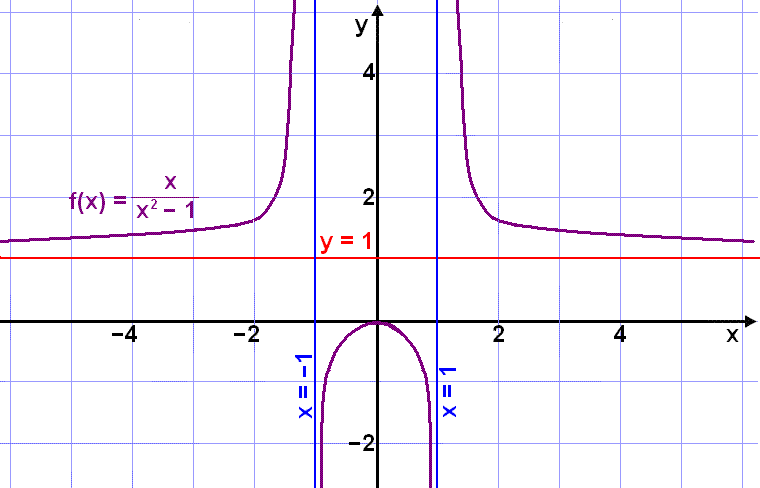
This graph follows a horizontal line ( red in the
diagram) as it moves out of the system to the left or right. This is a
horizontal asymptote with the equation y = 1. As x gets near to the values 1 and
1 the graph follows vertical lines ( blue). These vertical asymptotes
occur when the denominator of the function, n(x), is zero ( not the
numerator).
To find the equations of the vertical asymptotes we have to solve the equation:
x2 1 = 0
x2 = 1
x = 1 or x = 1
Near to the values x = 1 and x = 1 the graph goes almost vertically up or down and the function tends to either +∞ or ∞.
We get a
horizontal asymptote because
the numerator and the denominator, t(x) = x2 and n(x) = x2
1 are almost equal as x gets bigger and bigger.
If, for example, x = 100 then x2 = 10000 and x2
1 = 9999 , so that when we divide one by the othere we get almost 1. The
bigger the value of x the nearer we get to 1.
|
Vertical asymptotes can be found by solving the equation n(x) = 0 where n(x) is the denominator of the function ( note: this only applies if the numerator t(x) is not zero for the same x value). Horizontal asymptotes can be found by finding the limit
|
Example 1
Find the asymptotes for the
function ![]() .
.
To find the vertical asymptote we solve the equation
x 1 = 0
x = 1
The graph has a vertical asymptote with the equation x = 1.
To find the horizontal
asymptote we calculate
![]() .
.
The numerator always takes the value 1 so the bigger x gets the smaller the fraction becomes. For example if x = 1000 then f(x) = 001. As x gets bigger f(x) gets nearer and nearer to zero.
![]()
This tells us that y = 0 ( which is the x-axis ) is a horizontal asymptote.
Finally draw the graph in your calculator to confirm what you have found.
 |
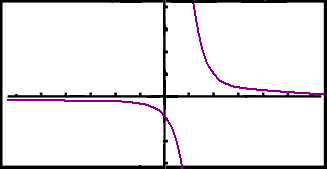
|
| The above example
suggests the following simple rule: A rational function in which the degree of the denominator is higher than the degree of the numerator has the x axis as a horizontal asymptote. |
Example 2
Find the asymptotes for ![]() .
.
We can see at once that there are no vertical asymptotes as the denominator can never be zero.
x2 + 1 = 0
x2 = 1 has no real solution
Now see what happens as x gets infinitely large:
![]()
The method we have used before to solve this type of problem is to divide through by the highest power of x.
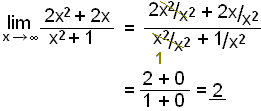 |
Divide all through by x2 and then cancel |
| fractions where x is in the denominator and not the numerator tend to 0. |
The graph has a horizontal asymptote y = 2.
Now lets draw the graph using the calculator
First choose GRAPH in the menu.
 |
 |
Then enter the formula being careful to include the brackets as shown

This is what the calculator shows us. The graph actually crosses its asymptote at one point. (This can never happen with a vertical asymptote).
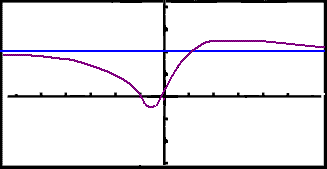
Example 3
Now an example where the numerator is one degree higher than the denominator.
![]() . The numerator is a second degree polynomial while the denominator is of the
first degree.
. The numerator is a second degree polynomial while the denominator is of the
first degree.
First the vertical asymptotes:
x 1 = 0
x = 1
One vertical asymptote with the equation x = 1.
We use long division and divide the numerator by the denominator
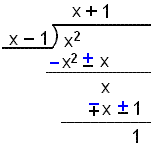
We can now rewrite f(x):
![]()
We know that
![]() which means that f(x) ≈ x + 1 as x gets bigger.
which means that f(x) ≈ x + 1 as x gets bigger.
telling us that the straight line y = x + 1 is a slanting asymptote
The graph is shown below.
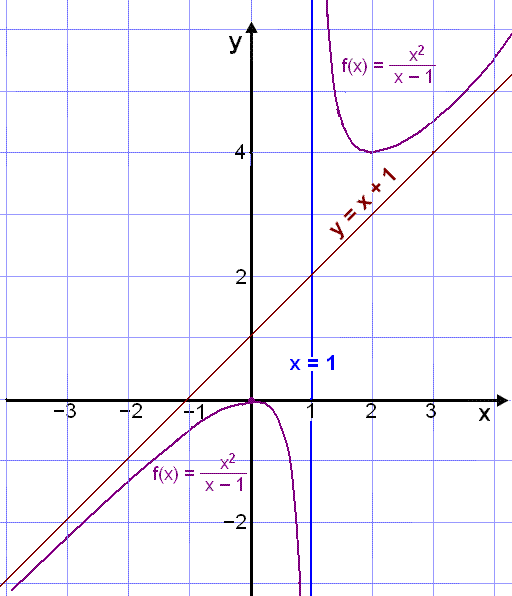
If we want to speculate on further possibilities we can see that if the degree of the numerator is 2 degrees greater than that of the denominator then the graph goes out of the coordinate system following a parabolic curve and so on.
Example 4
Find the asymptotes of the
function ![]() .
.
In this example the division has already been done so that we can see there is a slanting asymptote with the equation y = x.
To find the vertical asymptotes we solve the equation n(x) = 0.
x2 1 = 0
x2 = 1
x = 1 or x = 1
The vertical asymptotes are x = 1 and x = 1.
Here's the graph
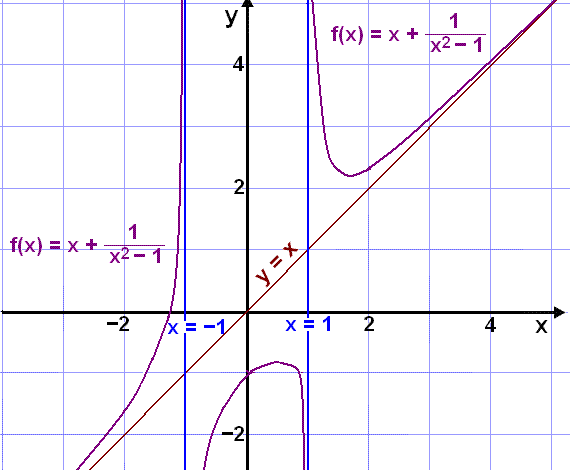
|
1) Vertical asymptotes
can occur when the denominator n(x) 2) If the degree of the
denominator n(x) is greater than that of 3)
If the degree of the
denominator n(x) is the same as that of 4)
If the degree of the
denominator n(x) is one less than that of |
Practise these methods then try
Quiz 3 on Functions 2.
Remember to use the checklist to keep track of your work.